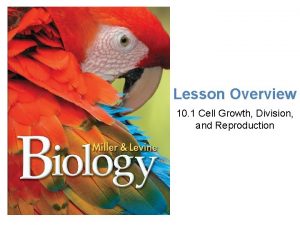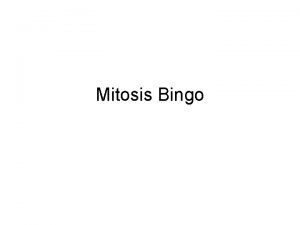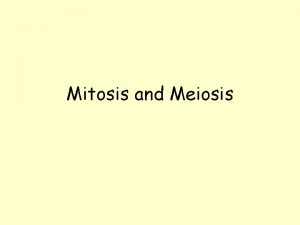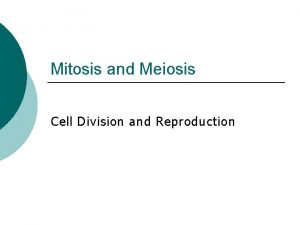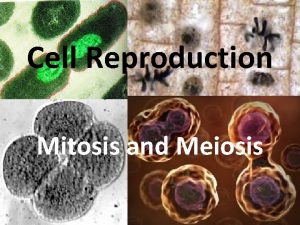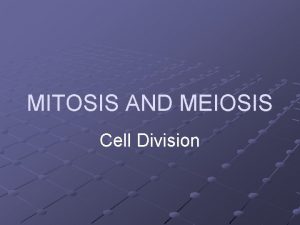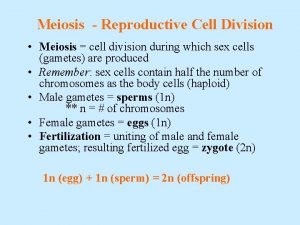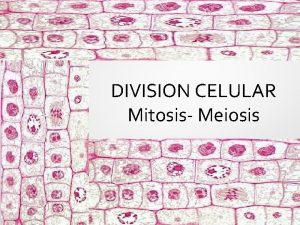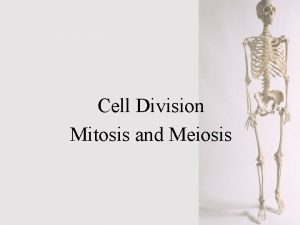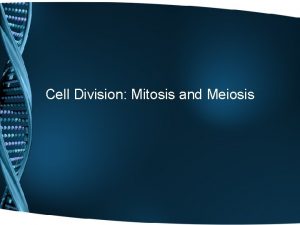Mitosis and Meiosis Cell Division and Reproduction MITOSIS













- Slides: 13

Mitosis and Meiosis Cell Division and Reproduction

MITOSIS q. Process of one cell making two new identical daughter cells q. Both new cells will have same number of chromosomes as original cell q. Both new cells with have DNA code as original cell

MITOSIS q. INTERPHASE: Cell is doing what cells need to do to survive, nucleus visible but no chromosomes are visible

MITOSIS q. PROPHASE: Nuclear membrane disappears, DNA replicates and becomes visible inside cell

MITOSIS • METAPHASE: Spindle fibers form at opposite sides of chromosomes; chromosomes line up in center of cell

MITOSIS q. EARLY ANAPHASE: Spindle fibers attach to chromosomes; pull one chromosome set to each side of cell

MITOSIS • LATE ANAPHASE: Chromosomes are at opposite sides of the cell; spindle fibers disappear

MITOSIS • TELOPHASE: New cell membrane forms between chromosome sets; two new cells formed; each ½ size of original cell

MITOSIS q. One large cell makes two smaller cells with same number of chromosomes; allows organisms to grow

MEIOSIS Ø One large cell will produce 4 smaller cells Ø Each cell will have ½ the normal number of chromosomes Ø Cells produced will fuse together during sexual reproduction Ø May be called egg and sperm or + and -

MEIOSIS Ø Looks like two versions of mitosis Ø DNA does not duplicate second time through prophase Ø 1 cell makes two identical cells, then each of these makes two cells with ½ the normal number of chromosomes

MEIOSIS Ø Egg cell and sperm cell combine to form zygote (new organism) Ø ½ chromosomes in egg + ½ chromosome in sperm = NEW ORGANISM WITH RIGHT NUMBER OF CHROMOSOMES

MEIOSIS • One cell makes 4 reproductive cells
 Cell division mitosis and meiosis
Cell division mitosis and meiosis Cell division mitosis and meiosis
Cell division mitosis and meiosis Cell growth division and reproduction
Cell growth division and reproduction Mitosis
Mitosis Asexual reproduction cell division
Asexual reproduction cell division Asexual reproduction cell division
Asexual reproduction cell division Mitosis cell division
Mitosis cell division Cell cycle and cell division
Cell cycle and cell division Cell cycle and cell division
Cell cycle and cell division Cell cycle phases
Cell cycle phases Asexualk
Asexualk Section 1 meiosis
Section 1 meiosis Chapter 10 section 3 gene linkage and polyploidy
Chapter 10 section 3 gene linkage and polyploidy Sexual vs asexual reproduction venn diagram
Sexual vs asexual reproduction venn diagram


